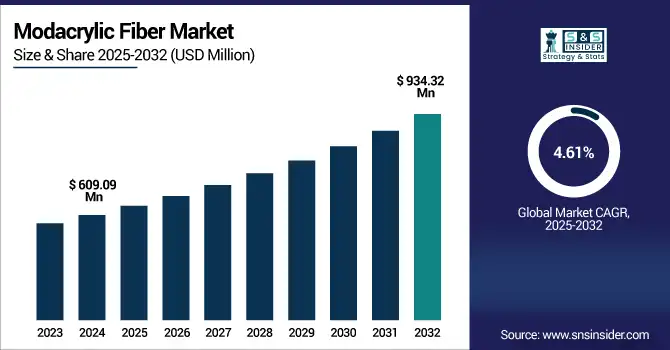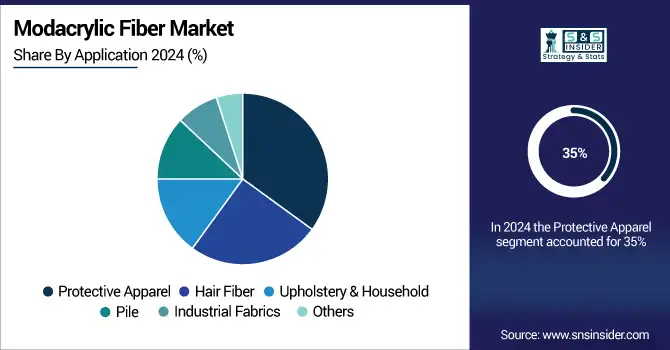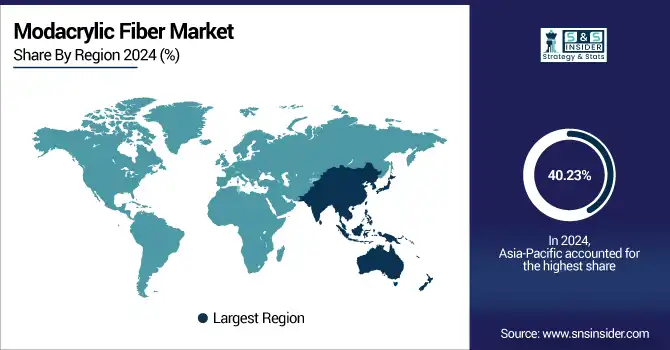Modacrylic Fiber Market Report Scope & Overview:
The modacrylic fiber market size was valued at USD 609.09 million in 2024 and is expected to reach USD 934.32 million by 2032, growing at a CAGR of 4.61% over the forecast period of 2025-2032.

To Get more information on Modacrylic Fiber Market - Request Free Sample Report
Modacrylic fiber market analysis indicates that an increase in the application of synthetic hair and wigs is a significant strength, triggering the growth of the modacrylic fiber market. Although modacrylic fibers are a favorite in the hair industry based on their lightweight, soft, and lifelike feeling, human hair absolutely remains the gold standard of hair. These fibers are used in wigs, hairpieces, and extensions and offer a flame-resistant, dyeable, and low-maintenance option. Soaring robust demand for fashion-styled styling, increasing hair loss problems, and increasing adoption of wigs into the ordinary elegance fashion have propelled the intake of artificial hair products. Likewise, demand is driven by the entertainment and cosplay industries, especially in countries with a large youth population. This segment has been utilizing modacrylic fibers consistently, which drives the modacrylic fiber market growth.
Market Dynamics:
Drivers
-
Rising Demand for Flame-Resistant Protective Apparel Drive the Market Growth
Inherent flame-retardant property of modacrylic fibers further renders them suitable for protective clothing in industrial, military, and fire-fighting applications. These fibers extinguish themselves when they touch the flames, and they do not shrink in extreme conditions. The rapid implementation of stringent workplace safety regulations in industries such as oil & gas, manufacturing, and utilities is expected to propel the growth of the agenda for the flame-retardant textiles market. To make it even more attractive, the fibre can be blended with other materials while retaining its protective capability. Specifically, the U.S Occupational Safety and Health Administration (OSHA) requires flame-retardant clothing in some workplace environments, which is additionally driving modacrylic fibers consumption in the country.
Restrain
-
High Production Costs and Limited Raw Material Availability May Hamper the Market Growth
The relatively high price of modacrylic fiber in comparison to other synthetic fibers, such as polyester, acrylic, etc. can be the major restraint for the growth of modacrylic fiber market. It is high-cost because of specialized manufacturing, stringent quality control, and reliance on certain types of petrochemical feedstreams. Raw materials, too, are at the mercy of volatility prices tracked to the global oil market.
For instance, acrylonitrile, required to produce modacrylics. This hampers the capability of smaller and medium sized manufacturers to compete at a price point, particularly so in price-sensitive fields such as mass-market apparel or single-use fabrics. This leads to market penetration typically being restricted to high-value or niche applications.
Opportunities
-
Rising Demand in Home Furnishings and Upholstery Creates Opportunities in the Market
More home furnishings and upholstery use modacrylic fibers because they are flame-resistant, hold their color, and wear well. They provide great protection against UV light and heat; therefore, they can be used for curtains, carpets, decorative pillows, and furniture fabric. Modacrylic's unique benefits present a most exclusive material, especially since consumers have raised the bar for safe and long-term textiles with the post-pandemic consciousness of clean and durable goods. The rise of the home décor and renovation market in North America and Europe has led manufacturers, on the other hand, to switch to advanced architectural or premium fibers that fulfill the aesthetic needs and regulatory requirements, which drive the modacrylic fiber market trends.
In September 2023, Kaneka Corporation announced the introduction of a high-performance, specialized-grade modacrylic fiber line for home upholstery applications. As part of this investment, an additional production line that is designed to expand the capacity of 5,000 tonnes per annum was built at its Malaysian plant to service the increasing worldwide demand, particularly for fire-retardant home textiles.
Segmentation Analysis:
By Application
Protective apparel held the largest modacrylic fiber market share, around 35%, in 2024. Its superior flame-retardant and thermal insulation function is due to the fibre's inherent chemistry. That's because modacrylic fibers are flame-resistant by nature and do not need additional chemical treatment to satisfy the safety standard, which makes them the perfect material for fire-resistant uniforms and fire gear. In the high-risk industries of oil & gas, electrical utilities, firefighting, and defense, where regulatory mandates for protective clothing are the most stringent, this is even more critical. The more blended with the other fiber, not affecting the fire protection, the more flexible application in the protective textile system the flame-resistant fibre showed.
Hair fiber held a significant modacrylic fiber market share. It is owing to rise in usage of synthetic wigs, extension and hairpieces in fashion, beauty and theatrical industries. Hair fiber applications are increasingly shifting from natural to modacrylic fibers due to their ease of styling, lighter weight, and strong resistance to heat and wear, making them a popular choice for consumers seeking both practicality and durability. This makes them perfect substitutes for real hair, especially in garments that need to be washed, styled, or dyed often.

Regional Analysis:
Asia-Pacific held the largest market share, around 40.23%, in 2024. It is owing to well-established manufacturing, low-cost labour, and rising demand in various end-user industries, which include protective apparel, synthetic hair, and home furnishings. With growing industrial infrastructure and increasing disposable incomes in regions such as China, Japan, South Korea, and India, these nations have become prominent production and consumption centers. It is also a prominent synthetic wig and hair extension production area, especially for export from China and South Korea. Furthermore, rising urbanization and the rise in acceptance of flame-retardant fabrics such as modacrylic amongst clients due to regulatory requirements on the use of flame-retardant materials in building materials and household textiles have boosted market growth.
In May 2024, South Korea Taekwang Industrial started shipping premium quality modacrylic wig yarn to the North America, Africa, capitalizing on the expanded production facilities and color range capabilities. The expansion is a result of the ramp-up of capacity and production efficiency in line with increasing demand for synthetic hair globally, as well as proclaiming Asia-Pacific’s position as a leader in producing Modacrylic Fiber.
North America modacrylic fibers market held a significant market share and is the fastest-growing segment in the forecast period. It is due to the high adoption of the product in the protective apparel & synthetic hair market. These stringent occupational safety regulations, especially in the U.S., have led to the growing need for flame-resistant materials in firefighting gear, industrial wear, and military uniforms, all of which open the door for modacrylic fibers given their built-in flame-retardant properties. Moreover, the U.S., among with the other countries in North America, mainly consumes synthetic wigs and hair extensions, bolstered by a diverse consumer base and rising consciousness of cosmetic and fashion trends. The increasing focus on home safety, along with a long-lasting product range, will also boost the modacrylic consumption for upholstery and furnishing.
The U.S. modacrylic fiber market size was USD 120.75 million in 2024 and is expected to reach USD 190.99 million by 2032 and grow at a CAGR of 5.77% over the forecast period of 2025-2032. It is owing to the high requirement for using flame retardant fiber in high-performance fibers applications like as protective apparel, synthetic hair, and industrial textiles. OSHA (Occupational Safety and Health Administration) is one of the American agencies propagating stringent workplace safety standards across the country, making flame-resistant (FR) clothing a requisite in high-risk industries like oil & gas, electrical utilities, and firefighting among others. As a result, modacrylic fibers that have flame-retardant properties built into their molecular structure have a fast-growing area of the market share because they do not require the addition of flame-retardant chemicals.
Europe held a significant market share in the forecast period. It is due to its high manufacturing capabilities, stringent regulations regarding fire safety, and a rising demand for high-performance, sustainable textiles. For instance, Germany, France, and the U.K. have an existing safety standard for industrial clothing, which requires the use of flame-resistant clothing in construction, energy, emergency services, and other occupational safety sectors, contributing to the growth of inherently flame-retardant fibers, including modacrylic. Moreover, demand for modacrylic fibres in upholstery and cabin components has surged, due to thermal stability and aesthetic versatility. Moreover, the strong global automotive and furniture industries of the region are expected to boost the modacrylic fibres market in the region. The demand for wigs and synthetic hair products in Europe is largely driven by the fashion-forward culture in European nations, followed by demand from theatrical and styling applications.

Get Customized Report as per Your Business Requirement - Enquiry Now
Key Players:
The major modacrylic fibers companies are BASF SE, The Dow Chemical Company, Eastman Chemical Company, SABIC Corporation, Huntsman Corporation, Amcotec Corporation, Mitsubishi Chemical Corporation, Shinshu Chemical Company, Tianjin Haier Chemical Industry Co., Ltd., JSC Sibur Holding.
Recent Development:
-
In January 2023, Kaneka opened a new modacrylic fiber manufacturing line in Pahang, Malaysia, adding regional capacity for flame-retardant and home-furnishing fibers.
-
In April 2024, Kaneka Price Adjustment on Japan/Malaysia April 2023 in October, Kaneka raised prices of its Kanecaron and Protex modacrylic fiber lines by JPY 50/kg, reinvesting proceeds on facilities upgrades and Q.C. capabilities at production sites.
| Report Attributes | Details |
|---|---|
| Market Size in 2024 | USD609.09 Million |
| Market Size by 2032 | USD 934.32 Million |
| CAGR | CAGR of 4.61% From 2025 to 2032 |
| Base Year | 2024 |
| Forecast Period | 2025-2032 |
| Historical Data | 2021-2023 |
| Report Scope & Coverage | Market Size, Segments Analysis, Competitive Landscape, Regional Analysis, DROC & SWOT Analysis, Forecast Outlook |
| Key Segments | •By Application (Metalworking, Personal Care, Industrial, and Others) |
| Regional Analysis/Coverage | North America (US, Canada, Mexico), Europe (Germany, France, UK, Italy, Spain, Poland, Turkey, Rest of Europe), Asia Pacific (China, India, Japan, South Korea, Singapore, Australia, Rest of Asia Pacific), Middle East & Africa (UAE, Saudi Arabia, Qatar, South Africa, Rest of Middle East & Africa), Latin America (Brazil, Argentina, Rest of Latin America) |
| Company Profiles | BASF SE, The Dow Chemical Company, Eastman Chemical Company, SABIC Corporation, Huntsman Corporation, Amcotec Corporation, Mitsubishi Chemical Corporation, Shinshu Chemical Company, Tianjin Haier Chemical Industry Co., Ltd., JSC Sibur Holding |

